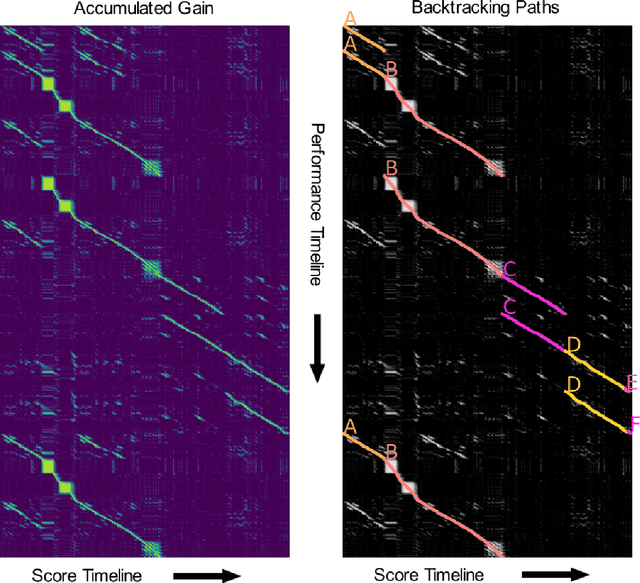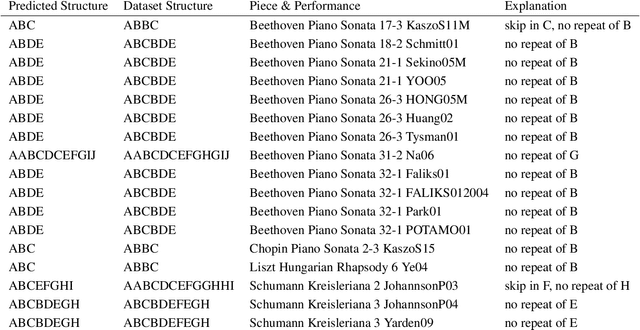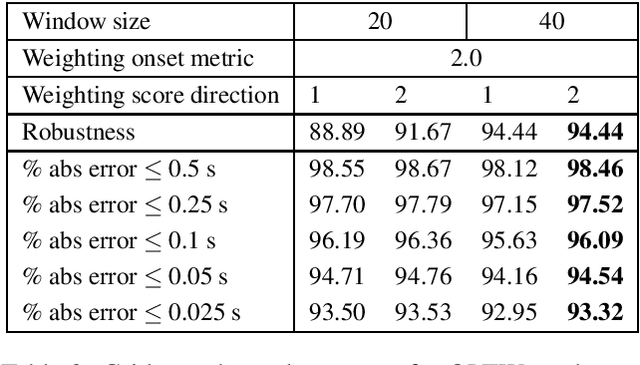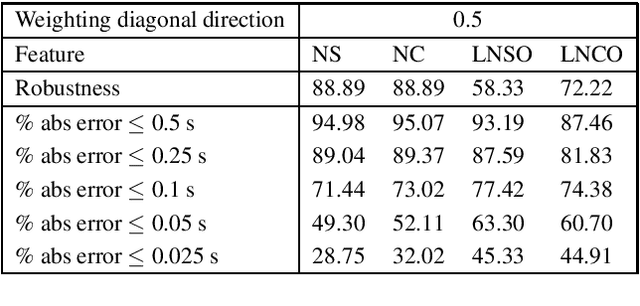Gerhard Widmer
Sound and Music Biases in Deep Music Transcription Models: A Systematic Analysis
Dec 16, 2025Abstract:Automatic Music Transcription (AMT) -- the task of converting music audio into note representations -- has seen rapid progress, driven largely by deep learning systems. Due to the limited availability of richly annotated music datasets, much of the progress in AMT has been concentrated on classical piano music, and even a few very specific datasets. Whether these systems can generalize effectively to other musical contexts remains an open question. Complementing recent studies on distribution shifts in sound (e.g., recording conditions), in this work we investigate the musical dimension -- specifically, variations in genre, dynamics, and polyphony levels. To this end, we introduce the MDS corpus, comprising three distinct subsets -- (1) Genre, (2) Random, and (3) MAEtest -- to emulate different axes of distribution shift. We evaluate the performance of several state-of-the-art AMT systems on the MDS corpus using both traditional information-retrieval and musically-informed performance metrics. Our extensive evaluation isolates and exposes varying degrees of performance degradation under specific distribution shifts. In particular, we measure a note-level F1 performance drop of 20 percentage points due to sound, and 14 due to genre. Generally, we find that dynamics estimation proves more vulnerable to musical variation than onset prediction. Musically informed evaluation metrics, particularly those capturing harmonic structure, help identify potential contributing factors. Furthermore, experiments with randomly generated, non-musical sequences reveal clear limitations in system performance under extreme musical distribution shifts. Altogether, these findings offer new evidence of the persistent impact of the Corpus Bias problem in deep AMT systems.
Perceptually Aligning Representations of Music via Noise-Augmented Autoencoders
Nov 10, 2025Abstract:We argue that training autoencoders to reconstruct inputs from noised versions of their encodings, when combined with perceptual losses, yields encodings that are structured according to a perceptual hierarchy. We demonstrate the emergence of this hierarchical structure by showing that, after training an audio autoencoder in this manner, perceptually salient information is captured in coarser representation structures than with conventional training. Furthermore, we show that such perceptual hierarchies improve latent diffusion decoding in the context of estimating surprisal in music pitches and predicting EEG-brain responses to music listening. Pretrained weights are available on github.com/CPJKU/pa-audioic.
A Study on the Data Distribution Gap in Music Emotion Recognition
Oct 06, 2025Abstract:Music Emotion Recognition (MER) is a task deeply connected to human perception, relying heavily on subjective annotations collected from contributors. Prior studies tend to focus on specific musical styles rather than incorporating a diverse range of genres, such as rock and classical, within a single framework. In this paper, we address the task of recognizing emotion from audio content by investigating five datasets with dimensional emotion annotations -- EmoMusic, DEAM, PMEmo, WTC, and WCMED -- which span various musical styles. We demonstrate the problem of out-of-distribution generalization in a systematic experiment. By closely looking at multiple data and feature sets, we provide insight into genre-emotion relationships in existing data and examine potential genre dominance and dataset biases in certain feature representations. Based on these experiments, we arrive at a simple yet effective framework that combines embeddings extracted from the Jukebox model with chroma features and demonstrate how, alongside a combination of several diverse training sets, this permits us to train models with substantially improved cross-dataset generalization capabilities.
MUSE-Explainer: Counterfactual Explanations for Symbolic Music Graph Classification Models
Sep 30, 2025Abstract:Interpretability is essential for deploying deep learning models in symbolic music analysis, yet most research emphasizes model performance over explanation. To address this, we introduce MUSE-Explainer, a new method that helps reveal how music Graph Neural Network models make decisions by providing clear, human-friendly explanations. Our approach generates counterfactual explanations by making small, meaningful changes to musical score graphs that alter a model's prediction while ensuring the results remain musically coherent. Unlike existing methods, MUSE-Explainer tailors its explanations to the structure of musical data and avoids unrealistic or confusing outputs. We evaluate our method on a music analysis task and show it offers intuitive insights that can be visualized with standard music tools such as Verovio.
Exploring System Adaptations For Minimum Latency Real-Time Piano Transcription
Sep 09, 2025Abstract:Advances in neural network design and the availability of large-scale labeled datasets have driven major improvements in piano transcription. Existing approaches target either offline applications, with no restrictions on computational demands, or online transcription, with delays of 128-320 ms. However, most real-time musical applications require latencies below 30 ms. In this work, we investigate whether and how the current state-of-the-art online transcription model can be adapted for real-time piano transcription. Specifically, we eliminate all non-causal processing, and reduce computational load through shared computations across core model components and variations in model size. Additionally, we explore different pre- and postprocessing strategies, and related label encoding schemes, and discuss their suitability for real-time transcription. Evaluating the adaptions on the MAESTRO dataset, we find a drop in transcription accuracy due to strictly causal processing as well as a tradeoff between the preprocessing latency and prediction accuracy. We release our system as a baseline to support researchers in designing models towards minimum latency real-time transcription.
Estimating Musical Surprisal from Audio in Autoregressive Diffusion Model Noise Spaces
Aug 07, 2025Abstract:Recently, the information content (IC) of predictions from a Generative Infinite-Vocabulary Transformer (GIVT) has been used to model musical expectancy and surprisal in audio. We investigate the effectiveness of such modelling using IC calculated with autoregressive diffusion models (ADMs). We empirically show that IC estimates of models based on two different diffusion ordinary differential equations (ODEs) describe diverse data better, in terms of negative log-likelihood, than a GIVT. We evaluate diffusion model IC's effectiveness in capturing surprisal aspects by examining two tasks: (1) capturing monophonic pitch surprisal, and (2) detecting segment boundaries in multi-track audio. In both tasks, the diffusion models match or exceed the performance of a GIVT. We hypothesize that the surprisal estimated at different diffusion process noise levels corresponds to the surprisal of music and audio features present at different audio granularities. Testing our hypothesis, we find that, for appropriate noise levels, the studied musical surprisal tasks' results improve. Code is provided on github.com/SonyCSLParis/audioic.
On Temporal Guidance and Iterative Refinement in Audio Source Separation
Jul 23, 2025Abstract:Spatial semantic segmentation of sound scenes (S5) involves the accurate identification of active sound classes and the precise separation of their sources from complex acoustic mixtures. Conventional systems rely on a two-stage pipeline - audio tagging followed by label-conditioned source separation - but are often constrained by the absence of fine-grained temporal information critical for effective separation. In this work, we address this limitation by introducing a novel approach for S5 that enhances the synergy between the event detection and source separation stages. Our key contributions are threefold. First, we fine-tune a pre-trained Transformer to detect active sound classes. Second, we utilize a separate instance of this fine-tuned Transformer to perform sound event detection (SED), providing the separation module with detailed, time-varying guidance. Third, we implement an iterative refinement mechanism that progressively enhances separation quality by recursively reusing the separator's output from previous iterations. These advancements lead to significant improvements in both audio tagging and source separation performance, as demonstrated by our system's second-place finish in Task 4 of the DCASE Challenge 2025. Our implementation and model checkpoints are available in our GitHub repository: https://github.com/theMoro/dcase25task4 .
TACOS: Temporally-aligned Audio CaptiOnS for Language-Audio Pretraining
May 12, 2025Abstract:Learning to associate audio with textual descriptions is valuable for a range of tasks, including pretraining, zero-shot classification, audio retrieval, audio captioning, and text-conditioned audio generation. Existing contrastive language-audio pretrained models are typically trained using global, clip-level descriptions, which provide only weak temporal supervision. We hypothesize that CLAP-like language-audio models - particularly, if they are expected to produce frame-level embeddings - can benefit from a stronger temporal supervision. To confirm our hypothesis, we curate a novel dataset of approximately 12,000 audio recordings from Freesound, each annotated with single-sentence free-text descriptions linked to a specific temporal segment in an audio recording. We use large language models to clean these annotations by removing references to non-audible events, transcribed speech, typos, and annotator language bias. We further propose a frame-wise contrastive training strategy that learns to align text descriptions with temporal regions in an audio recording and demonstrate that our model has better temporal text-audio alignment abilities compared to models trained only on global captions when evaluated on the AudioSet Strong benchmark. The dataset and our source code are available on Zenodo and GitHub, respectively.
How to Infer Repeat Structures in MIDI Performances
May 08, 2025

Abstract:MIDI performances are generally expedient in performance research and music information retrieval, and even more so if they can be connected to a score. This connection is usually established by means of alignment, linking either notes or time points between the score and the performance. The first obstacle when trying to establish such an alignment is that a performance realizes one (out of many) structural versions of the score that can plausibly result from instructions such as repeats, variations, and navigation markers like 'dal segno/da capo al coda'. A score needs to be unfolded, that is, its repeats and navigation markers need to be explicitly written out to create a single timeline without jumps matching the performance, before alignment algorithms can be applied. In the curation of large performance corpora this process is carried out manually, as no tools are available to infer the repeat structure of the performance. To ease this process, we develop a method to automatically infer the repeat structure of a MIDI performance, given a symbolically encoded score including repeat and navigation markers. The intuition guiding our design is: 1) local alignment of every contiguous section of the score with a section of a performance containing the same material should receive high alignment gain, whereas local alignment with any other performance section should accrue a low or zero gain. And 2) stitching local alignments together according to a valid structural version of the score should result in an approximate full alignment and correspondingly high global accumulated gain if the structural version corresponds to the performance, and low gain for all other, ill-fitting structural versions.
Pairing Real-Time Piano Transcription with Symbol-level Tracking for Precise and Robust Score Following
May 08, 2025


Abstract:Real-time music tracking systems follow a musical performance and at any time report the current position in a corresponding score. Most existing methods approach this problem exclusively in the audio domain, typically using online time warping (OLTW) techniques on incoming audio and an audio representation of the score. Audio OLTW techniques have seen incremental improvements both in features and model heuristics which reached a performance plateau in the past ten years. We argue that converting and representing the performance in the symbolic domain -- thereby transforming music tracking into a symbolic task -- can be a more effective approach, even when the domain transformation is imperfect. Our music tracking system combines two real-time components: one handling audio-to-note transcription and the other a novel symbol-level tracker between transcribed input and score. We compare the performance of this mixed audio-symbolic approach with its equivalent audio-only counterpart, and demonstrate that our method outperforms the latter in terms of both precision, i.e., absolute tracking error, and robustness, i.e., tracking success.
 Add to Chrome
Add to Chrome Add to Firefox
Add to Firefox Add to Edge
Add to Edge